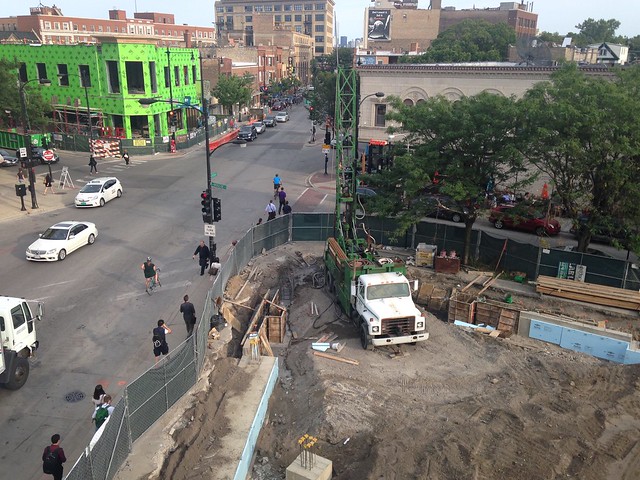
Tomorrow’s the big day. On Monday, City Council’s Zoning Committee unanimously passed Mayor Rahm Emanuel’s proposed reforms to Chicago’s existing transit-oriented development ordinance. On Thursday, the full council will almost certainly approve the new legislation, paving the way for a new wave of dense, parking-lite development near train stations. However, the committee made three notable changes to the new ordinance.
The TOD reform ordinance will more than double the reach of the original TOD ordinance, passed in 2013. Currently, new residential buildings within 600 feet of a Metra or ‘L’ stop (1,200 feet on designated Pedestrian Streets) are required to provide at least a 1:2 ratio of parking spots to units, instead of the usual 1:1 ratio.
Under the reform ordinance, land zoned for business (B), commercial (C), downtown (D) or industrial (M) uses within 1,320 feet of a station will be freed from the minimum parking requirements altogether, including. On Pedestrian Streets, the zone would be expanded to 2,640 feet.
The legislation will also increase the density allowance for certain parcels within these new TOD districts if the developer provides on-site affordable housing. Buildings in which ten percent of the units are affordable will get the maximum density bonus.
These changes will increase the housing supply near rapid transit and encourage walkable retail. This will make it easier for residents to access jobs and will reduce car dependency. Families will save on transportation costs, and the additional population density will help local merchants. Because developers won’t be forced to include more off-street parking than the market demands – at least $20,000 per space – expanded TOD may also help reduce housing costs.
However, some of the dense, low-parking development that has occurred under the current ordinance has been controversial. Many of the new buildings have faced oppositions from neighbors who fear that more residents in a community necessarily means more cars, and have pushed for higher parking ratios.
And, while TOD is an effective strategy for providing transportation options and boosting retail in all kinds of neighborhoods, all of the current projects are being developed in North Side neighborhoods and feature high-end apartments. While this increases the local housing supply, groups such as Somos Logan Square have argued that the addition of upscale units to gentrifying neighborhoods fuels the displacement of low-income and working-class residents.
The Metropolitan Planning Council has been one of the leading proponents of the new TOD ordinance. Executive vice president Peter Skosey discussed the three changes that aldermen made to the ordinance before it passed the Zoning Committee.
To speed the approval process for TOD projects, the reform ordinance originally called for the elimination of parking requirements and approval of increased density to take place on an “as of right” basis, through the Administrative Adjustment process. That would have dropped the requirement for the local alderman to sign off on these changes. Predictably, many politicians – some of whom rely on leverage over developers for campaign contributions – didn’t like that idea.
As it stands now, the new ordinance will allow aldermen to write a letter or testify before the Zoning Board of Appeals, and it’s uncommon for the board to go against the alderman’s wishes, Skosey said. Since aldermen are beholden to their constituents, that change will likely be viewed as a win by residents who argued that the TOD reform ordinance wouldn’t give community members enough input on new building projects.
As the new ordinance was originally written, developers would had to have gone through the city’s planned development process in order to get the density bonus. Now they’ll only have to go through a Type 1 zoning process, which will cut the approval time in half, according to Skosey. “MPC supports that,” he said.
The third tweak allows for a greater number of efficiency units – studios and one-bedrooms – within a few hundred feet of stations. Skosey said this change makes sense, because there’s currently a high demand from young, single people for apartments near transit, and many of these renters aren't interested in owning cars.
Skosey said that revised law is very likely to pass at tomorrow’s City Council hearing. “Generally, if things are approved in committee, they pass in council.”
He argued that the reforms to the ordinance are way overdue. “At a time when demand for transit-oriented development is so high, Chicago is not meeting the demand,” he said. “We need to facilitate and streamline the process for building more units so we can bring housing prices down overall, especially in high demand areas.”


